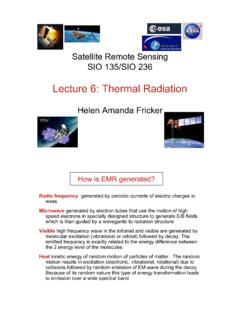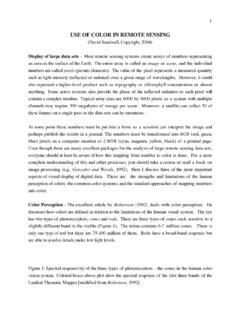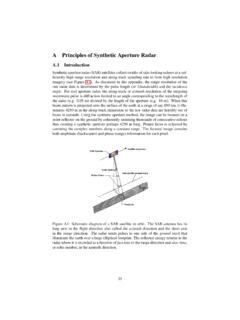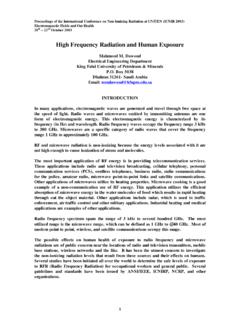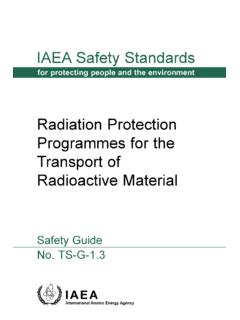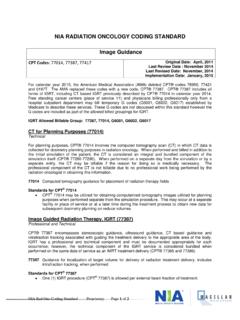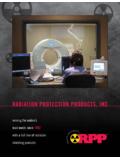Transcription of Thermal Radiation
1 Satellite Remote Sensing SIO 135/SIO 236. Thermal Radiation How is EMR generated? Radio generated by periodic currents of electric charges in wires. Microwave generated by electron tubes that use the motion of high speed electrons in specially designed structure to generate E/B fields Visible high frequency wave in the infrared and visible are generated by molecular excitation (vibrational or orbital) followed by decay. The emitted frequency is exactly related to the energy difference between the two energy level of the molecules. Heat kinetic energy of random motion of particles of matter.
2 The random motion results in excitation (electronic, vibrational, rotational) due to collisions followed by random emission of EM wave during the decay. Because of its random nature this type of energy transformation leads to emission over a wide spectral band. Thermal Radiation Thermal Radiation is emitted by all objects above absolute zero ( C). Spectrum of this Radiation ( intensity vs wavelength) usually follows the idealized black-body Radiation curve Stefan-Boltzmann law: Total energy emitted over time by a black body is proportional to T4. Wiens displacement law: The wavelength of the spectral peak is proportional to T-1.
3 What is a black body ? A black body (BB) emits a temperature-dependent spectrum of wavelengths in nm light Thermal Radiation from a black body is termed black-body Radiation At room temperature, BBs emit mostly infrared light, but as the temperature increases past a few hundred C, BBs start to emit visible wavelengths (shorter and shorter). red orange yellow white blue beyond this the emission includes increasing amounts of UV. Wavelength (color) of BB Radiation depends on the temperature of the BB. Thermal channels of the EM spectrum In general a hot object will distribute its emission over a range of wavelengths in a continuous spectrum.
4 What is a black body ? A black body is an idealized object that absorbs all EMR that falls on it -- no EMR. passes through it and none is reflected (perfect emitter and perfect absorber). Because no light (visible EMR) is reflected or transmitted, the object appears black when it is cold. Term introduced by Gustav Kirchhoff in 1860. Black body lab experiment An object of controlled temperature T contains a cavity, joined to the outside by a small hole. If the hole is small, the Radiation in the cavity comes to equilibrium with the walls. The hole allows a small fraction of the Radiation to pass to a spectrometer -- the Radiation coming out has the same spectrum as what is inside Black body lab experiment Plot of Planck's Radiation law for two temperatures.
5 Note that the peak of the curve moves to the left as the temperature increases: hotter objects output a larger fraction of their EMR at shorter wavelengths. Note also the strong dependence on temperature of the total emission. The radiancy is the power emitted per unit area per increment of wavelength and so has units of W m-3. Black body lab experiment The spectral radiance from the hole is independent of the material used and only depends on the temperature Describing angular distributions of Radiation Consider a plane surface illuminated by EMR from a variety of directions Two angles are needed to specify a particular direction of incident Radiation : - angle between incident ray and normal to surface - azimuthal angle, measured around normal in place of surface Describing angular distributions of Radiation Consider element dA of the surface, and Radiation incident d over range of angles to +d.
6 And to + d . Solid angle d = sin d d . Power incident on the element dA from this range of directions is proportional to dA & d , and a term L which gives the strength of Radiation dP = L cos d d . L is radiance - SI unit is W m-2 sr -1. Spectral radiance Spectral radiance L is defined as the radiance L contained in a small range of wavelengths and given by: L = L . L is the differential of L wrt . L = | L/ |. Spectral radiance - SI unit is W m-2 sr-1 m-1. = W m-3 sr -1. Radiance Spectral radiance (L ) is the radiant flux per unit solid angle leaving an extended source in a given direction per unit projected source area in that direction Radiant flux in certain wavelengths (L ) leaving the projected source area (A) within a certain direction ( ).
7 And solid angle ( ): Jensen 2005. units W m-3 sr -1. Planck s law Describes the amplitude of Radiation emitted ( , spectral radiance) from a black body. It is generally provided in one of two forms: 1) L ( ) is the radiance per unit wavelength as a function of wavelength . 2) L ( ) is the radiance per unit frequency as a function of frequency . 1). Planck s law To relate the two forms and establish L ( ), we take the derivative of L. with respect to using the chain rule: Since = c/ , so that which gives: Stefan-Boltzmann Law The total emitted Radiation (M ) from a black body is proportional to the fourth power of its absolute temperature.
8 Where is the Stefan-Boltzmann constant, x 10-8 W m-2 K -4. the amount of energy emitted by an object such as the Sun or the Earth is a function of its temperature. This can be derived by integrating the spectral radiance over the entire spectrum or M= L= T4. Wien s displacement law In addition to computing the total amount of energy exiting a theoretical blackbody such as the Sun, we can determine its dominant wavelength ( max) based on Wien's displacement law: where k is Wien's displacement constant = x 10-3 K m, and T is the absolute temperature in K. there is an inverse relationship between the wavelength of the peak of the emission of a black body and its temperature.
9 Therefore, as the Sun approximates a 6000 K blackbody, its dominant wavelength ( max ) is m. Rayleigh-Jeans approximation Convenient and accurate description for spectral radiance for wavelengths much greater than the wavelength of the peak in the black body Radiation formula >> max Approximation is better than 1% when hc/ kT << 1. or T > m K. For example, for a body at 300 K, the approximation is valid when > mm; in other words this approximation is good when viewing Thermal emissions from the Earth over the microwave band. EM Energy from the Sun Thermonuclear fusion on the surface of the Sun (temp 5770 6000 K) yields a continuous spectrum of EM energy ranging from short, high frequency gamma &.
10 Cosmic waves to long, low frequency radio waves; majority of the energy is relatively short wavelength Travels through space at the speed of light & takes 8 minutes reach Earth (150. million km). Some energy is intercepted by the Earth, where it interacts with the atmosphere and surface materials; some is reflected directly back out to space; and some is absorbed and then re-emitted it at a longer wavelength Earth approximates a 300 K (27 C) blackbody, dominant wavelength is ~ mm EM Energy from the Sun EM Energy from the Sun Max Radiation emission (41%) is in the visible ( m). 59% of the energy is in wavelengths shorter than blue light (< m) and longer than red light (> m).
